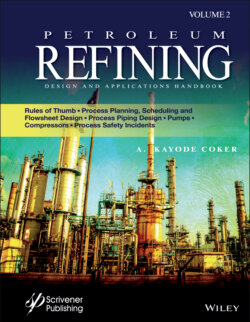Читать книгу Petroleum Refining Design and Applications Handbook - A. Kayode Coker - Страница 21
TRAY TOWERS
Оглавление1 1. For reasons of accessibility, tray spacings are made 0.5–0.6 m (20–24 in.).
2 2. Peak efficiency of trays is at values of the vapor factor Fs = µ(ρv)0.5 in the range of 1.2–1.5 m/s (kg/m3)0.5 [1–1.2 ft/s (lb/ft3)0.5]. This range of Fs establishes the diameter of tower. Roughly, linear velocities are 0.6 m/s (2 ft/s) at moderate pressures and 1.8 m/s (6 ft/s) in vacuum.
3 3. Pressure drop per tray is of the order of 747 Pa (3 in. water) or 689.5 Pa (0.1 psi).
4 4. Tray efficiencies for distillation of light hydrocarbons and aqueous solutions are 60–90%; for gas absorption and stripping, 10–20%.
5 5. Sieve trays have holes of 6–7 mm (0.25–0.50 in.) diameter, hole area being 10% of the active cross section.
6 6. Valve trays have holes of 38 mm (1.5 in.) diameter, each provided with a liftable cap, with 130–150 caps per square meter (12–14 caps per square feet) of active cross section. Valve trays are usually cheaper than sieve trays.
7 7. Bubble cap trays are used only when liquid level must be maintained at low turndown ratio; they can be designed for lower pressure drop than either sieve or valve trays.
8 8. Weir heights are 50 mm (2 in.), weir lengths are about 75% of trays diameter, and liquid rate a maximum of about 1.2 m3/min-m of weir (8 gpm/in. of weir); multi-pass arrangements are used at higher liquid rates.
